It’s time for another installment in our series of how I prepared our dog Baxter for the birth of our first baby. Today’s post is all about that important baby accessory—the stroller—and that important moment in many dogs’ days—the W-A-L-K.
To see all of the posts in this baby prep series, click here. A reminder that if you have serious behavior concerns or special needs particularly when adding a baby to your family, our best advice is to work with a reputable, professional trainer.
How to Train Your Dog to Walk With A Stroller
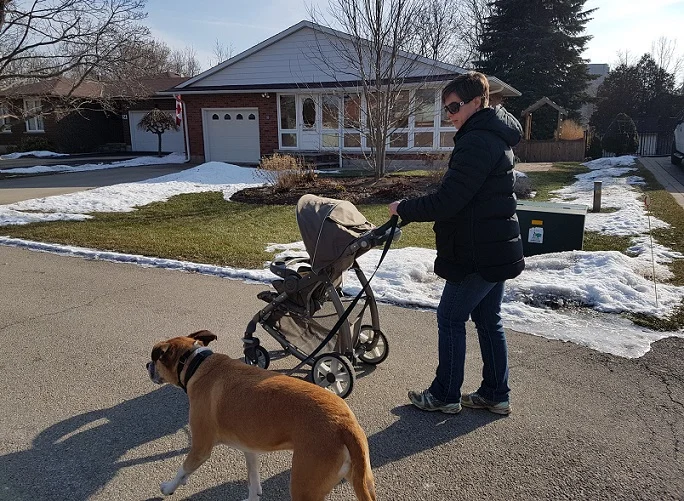
Imagine strolling along on a nice sunny day, baby napping quietly in the stroller, dog walking placidly alongside, Mama rested and relaxed (it could happen, right?).
Then consider the flipside.
Tight leash, Mama and stroller zigzagging down the sidewalk as dog pulls wherever he wants to go, Mama’s shoulder sore from being jerked, baby crying because it’s having a bumpy ride (or even worse, because the stroller has overturned!).
Walking a dog on leash is not straightforward. Walking a dog with a stroller is even more complicated, so this is definitely something I wanted to practice with Baxter before our baby arrived.
Step one, loose leash walking with a stroller
Do not introduce the stroller until your dog walks reliably with a loose leash.
My favourite leash is six feet long. I find this length gives Baxter the freedom to sniff and trot along at a comfortable distance, but it also gives me control if I need it.
In preparing for stroller walks, I do not recommend a retractable leash. It’s too easy for these types of leashes to tangle around you, the stroller, trees and become a hazard when walking.
We’re fortunate that Baxter is pretty good on leash already. If he feels tension on the lead, he tends to adjust his pace, rather than pulling harder. However, he occasionally needs reminders that he’s not the one setting the speed.
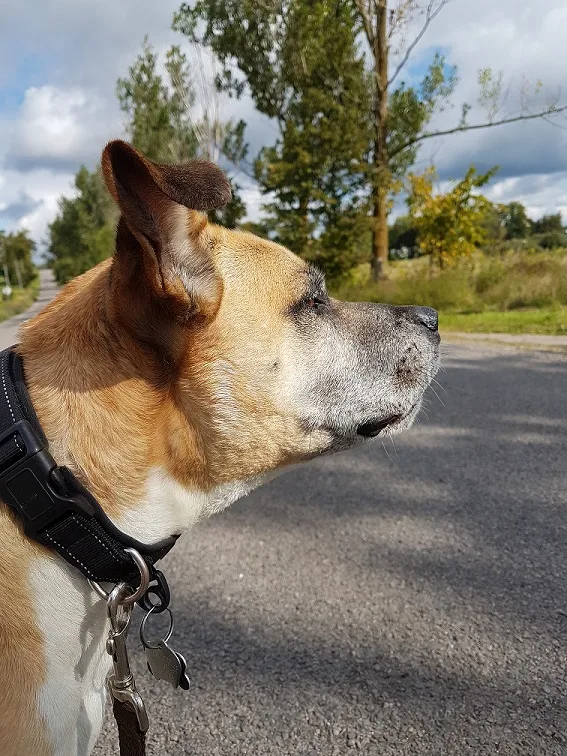
The technique that has worked best for me is to simply stop walking when he pulls. This is usually sufficient for him to remember, “Oh right. You’re attached to me. And you’re bigger than me. I guess I’ll slow down.”
After that, if he starts to pull again, a comment from me like “Watch your pace, buddy” is usually enough to tune him back into me and slow him down.
A natural training opportunity has occurred over the course of my pregnancy as my speed has definitely decreased.
I’m just not able to walk as fast as I usually do. Baxter has adjusted accordingly and will look over his shoulder more often to see how I’m doing.
A note that most caregivers encourage pregnant women to maintain their fitness throughout their pregnancies.
Finding out you’re pregnant is not the time to start a new workout routine, but our midwife has been very happy that we have a dog—and therefore a reason—to get out for daily walks.
As always, check with your care provider to make sure you’re making healthy choices for yourself and your baby.
As we’ve been practicing loose leash walking, we’ve also practiced a few helpful commands
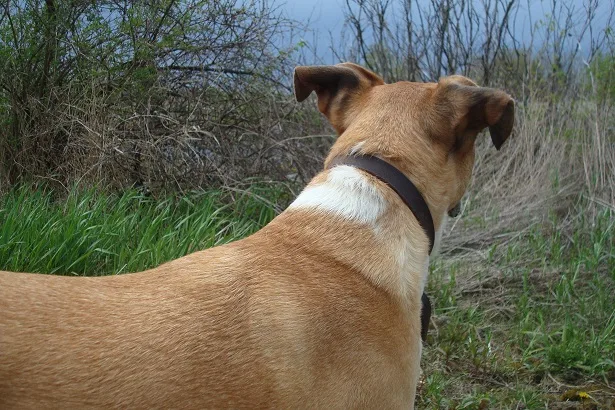
“With me”—our command of “no, you can’t go sniff right now, keep walking.” See our post: Increase your dog’s focus on walks.
“Wait”—“stop walking until I start moving again” helpful for when the baby drops a toy or pacifier out of the stroller… or the day this uncoordinated pregnant lady tripped in the deep snow and ended up face first in a drift—bonus the snow was soft enough that baby didn’t get squished
“Far enough”—“You’ve gone far enough off the path. Don’t take another step and don’t pull, but we can stand here and sniff for a minute.”
“Heel”—For those times when we need it. Meaning, walk at my side closely.
You may decide that you want your dog in a formal heel position most of the time or to walk on a particular side of you. After you’ve mastered loose leash walking, but before you introduce the stroller, establish the new rules of engagement with your dog and practice until they’re habit for both of you.
For me, as long as the leash is loose, that’s sufficient. I tend not to mind if Baxter is in front, behind or to the side. However, with a stroller, he has to pick a side and can’t range around me quite as freely as he used to.
Step two, introduce the stroller to your dog
Set up the stroller and let your dog investigate it at his own pace. He should be able to sniff and look around as much as he wants. If he seems particularly nervous, you can offer him some treats or drop some around the stroller to build a positive association for your dog.
Don’t drop the treats in the stroller. You do not want to encourage your dog to equate the stroller to a treat dispenser and root around when a baby is sitting there.
Go for a walk, but have a friend push the stroller while you walk your dog as normal. This will help your dog to become familiar with how the stroller moves and associate it with his walks.
If your dog seems at all uncertain or nervous, repeat step two as many times as needed. You want him to be relaxed and associate the stroller with goodness—like a walk.
Step three, loose leash walking with the stroller & your dog
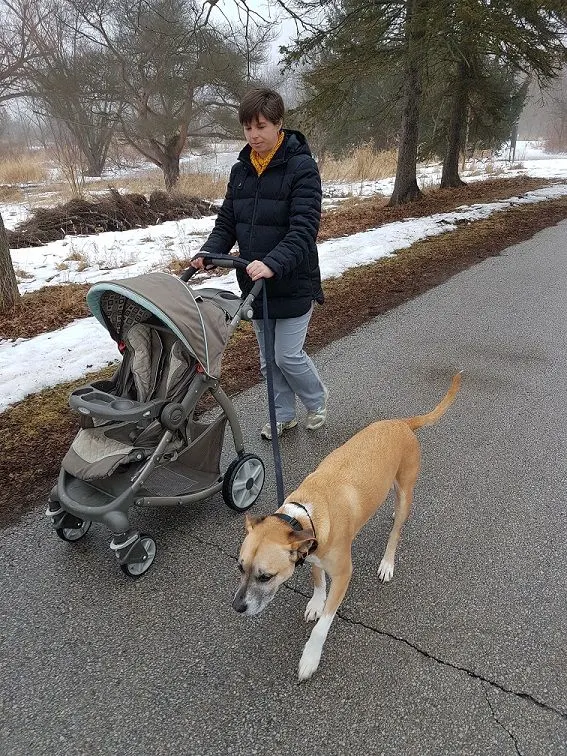
Once your dog seems comfortable with the stroller’s presence, it’s time to learn to walk with it.
I clocked many kilometres—and many strange looks—pushing an empty stroller! Before we ever headed out with a baby, I wanted Baxter to be familiar with how the stroller moved and be confident moving with it.
The best way I found to teach “watch out for the stroller” was to keep pushing, even if Baxter was in the stroller’s path. Being bumped by the stroller or one of its wheels taught him quickly that he needed to pay attention to where this rollie thing was.
While your hands may be full with pushing the stroller, it’s important not to attach the leash to the stroller.
No matter how well-trained your dog is, there may be a time where he darts away from you. Being able to let go of the leash and not having a danger of the stroller being tipped or dragged is critical.
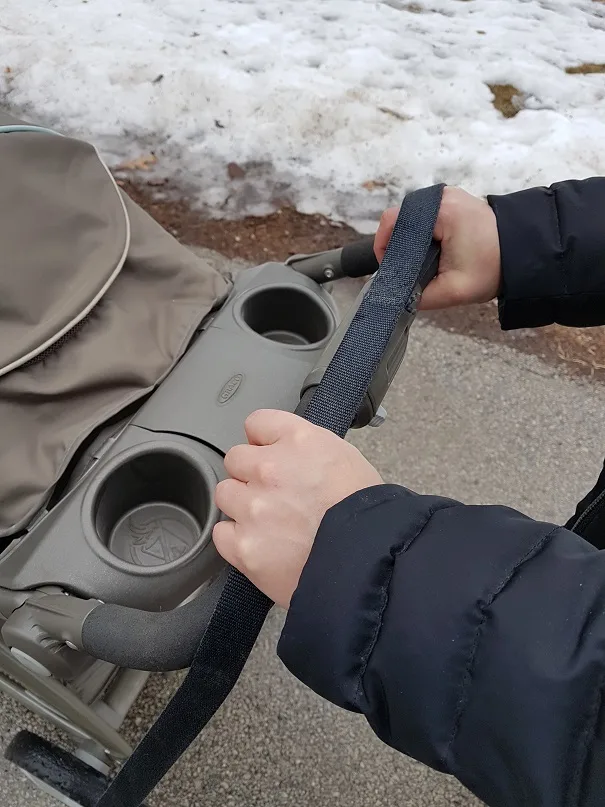
Initially I put the loop around my wrist and gave Baxter the full length of the leash so that he could move around as much as he wanted. However, this gave him so much leash that he could walk right in front of the stroller and wrap us all up.
To gain slightly more control, I laid the leash along the stroller handle to make it a bit shorter. Baxter soon learned he couldn’t walk in front of the stroller and had to stay beside it.
I’m also hoping to find alternatives to walking Baxter with the stroller. This may mean putting the baby in a carrier or finding a gentle hiking spot where Baxter can go off leash and the stroller can still roll.
It may even sometimes mean heading out without baby for some one-on-one time with my dog.
Update: We’ve done some hiking without the stroller!

Tips for walking your dog with a stroller
1. Master loose leash walking. This basic skill is the most important step for safe and successful stroller walks. Don’t add the stroller to your walks until your dog reliably walks with a loose leash.
2. Use a basic 6-foot leash. This length gives the dog plenty of freedom to move around, but also gives you control over your dog. Avoid retractable (Flexi) leashes that may get tangled around the stroller.
3. To heel or not to heel. You may decide it’s easiest if your dog is in a heel position or if he walks on a particular side of you. Train this behaviour before introducing the stroller. See our post: Should I teach my dog to heel?
4. Introduce the stroller slowly. Let your dog “meet” the stroller by sniffing it. Have a friend push the stroller while you walk your dog. Once he seems comfortable, start walking him yourself while pushing the stroller.
5. Do not attach the leash to the stroller. Keep everyone safe and keep the leash in your hand. Consider a waist leash if you want to keep your hands free.
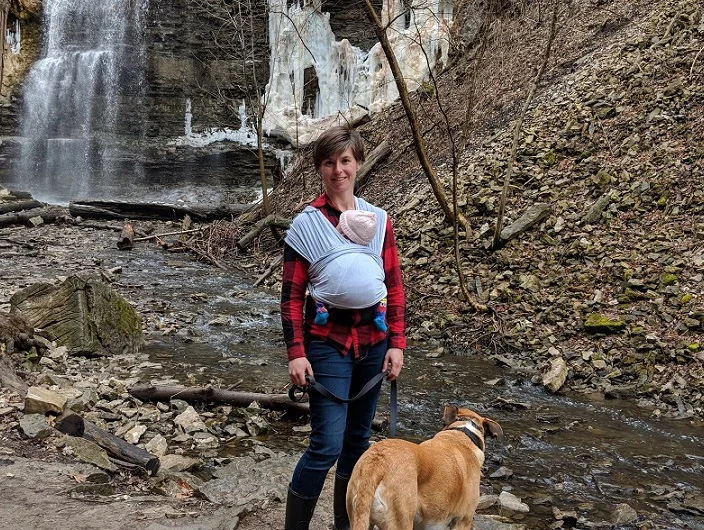
6. Make time to walk without the stroller. Use a carrier, go off-leash or leave the baby with a sitter. Walks are some of the most enjoyable time Baxter and I have together.
I’m looking forward to sharing those with baby and finding ways to make them pleasurable for all of us.
Do you have any tips for walking a dog while pushing a stroller?
What techniques have worked for you for teaching loose leash walking?
Julia Preston is a blogger at Home on 129 Acres where she writes about her adventures of country living and DIY renovating. She writes regularly for That Mutt.
Related articles:
- Get your dog to pay attention off leash
- Should I teach my dog to heel?
- First greeting between dog and baby

Ryan Olivas
Wednesday 18th of July 2018
I was entertained of your photos. Your tips really helps, my sister will be giving birth next month so i think she really need to read this.
Jese Beard
Monday 16th of July 2018
I hope I will be able to accomplish this with my dog. Do you have any recommendations for a GPS tracker for my corgi? Anyway, thank you for this helpful guide. I enjoyed reading.
Rily
Wednesday 11th of July 2018
This is very helpful!
Will
Monday 21st of May 2018
Awesome tutorial! I'm sure I'll be coming back to it when Lincoln gets too big to carry. But (at least for now) I find it much more manageable to have him on my chest/back like in your hiking photos. If you're in the market, I really like the Onya Outback carrier for walks/hikes. Really durable and functional. One of my favorite things we've purchased.
Julia at Home on 129 Acres
Monday 21st of May 2018
I confess I'm a huge carrier fan too, Will. Especially since most of our walks are on the fields at our farm, our stroller actually doesn't get a lot of use. Thanks for the suggestion of the Onya. We have a soft wrap carrier that I love (Huggaloops) and a Bjorn. The one thing that I find is now that the weather is warmer, Ellie gets too hot sometimes on our walks. We both are pretty sweaty when I peel her off me! Have you encountered any issues like that with your Onya?